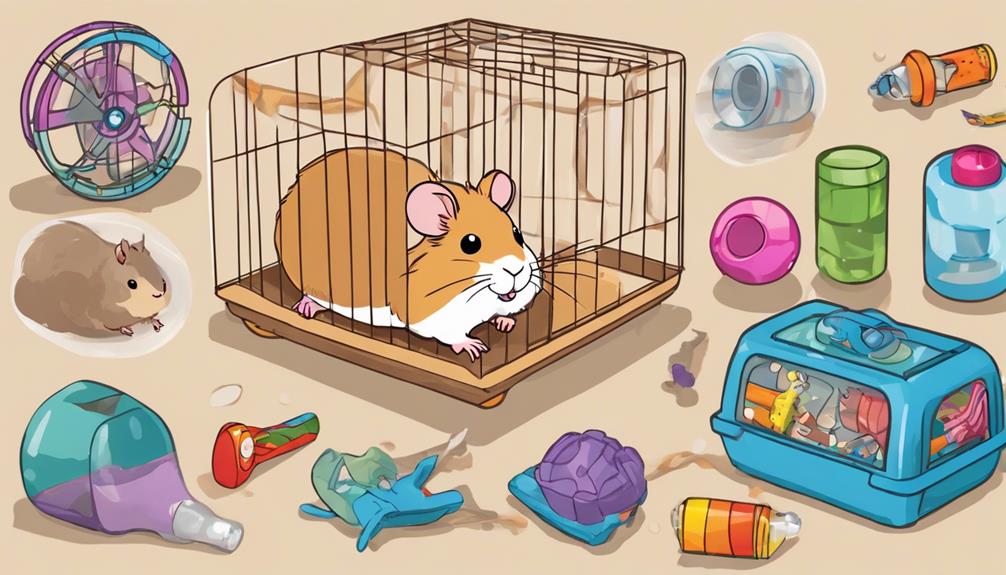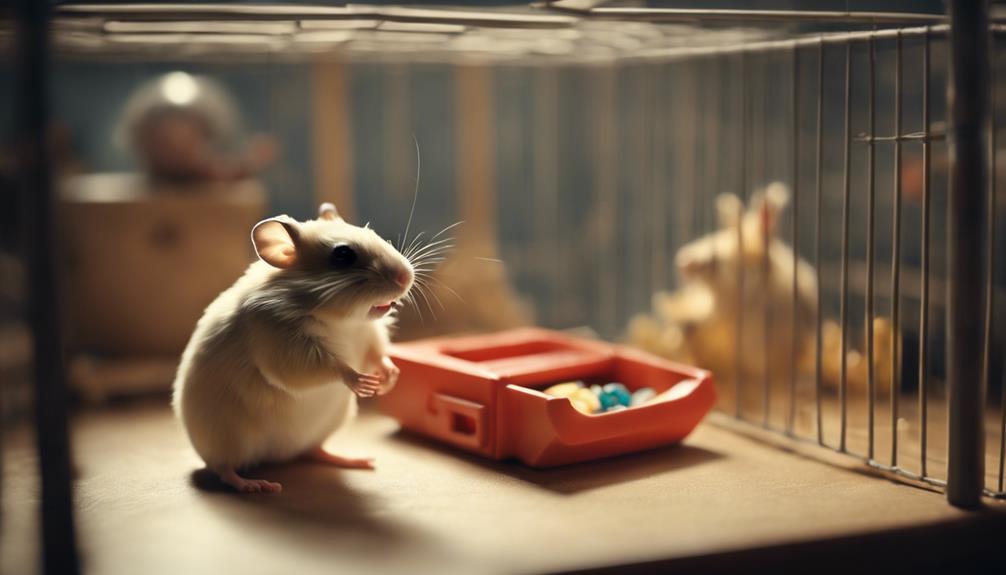When Should You Introduce New Toys to Your Hamster's Cage?

Timing is crucial when introducing new toys to your hamster's cage for their well-being and happiness. Consider factors like your hamster's age, familiarity with surroundings, and signs of boredom or stress.
This ensures a fulfilling and engaging life in their cozy habitat.
Age of Your Hamster
When introducing new toys to your hamster's cage, consider the age of your furry friend to ensure the toys are suitable and safe for them to enjoy. Understanding your hamster's activity level is crucial in selecting the right toys. Young hamsters tend to be more energetic and curious, so toys that encourage exploration and physical activity are ideal for them. On the other hand, older hamsters may prefer more relaxed activities, such as puzzle feeders or chew toys.
Establishing a playtime schedule based on your hamster's age is essential to keep them mentally and physically stimulated. Young hamsters may benefit from shorter, more frequent play sessions to burn off excess energy, while older hamsters may enjoy longer, leisurely playtimes. By tailoring your hamster's playtime schedule to their age, you can provide them with the right amount of stimulation and prevent boredom. Remember, a happy hamster is an active hamster!
Familiarity With Current Environment
Consider how familiar your hamster is with its current environment before introducing new toys to its cage to ensure a smooth transition and optimal enjoyment for your furry companion. Hamsters thrive when they feel safe and secure in their surroundings, so it's essential to gauge their level of comfort before making any changes.
Start by observing your hamster's behavior during cage exploration. If your pet confidently navigates its cage, interacts with different areas, and shows curiosity towards its current toys, it may be ready for some new additions. On the other hand, if your hamster seems hesitant, spends a lot of time hiding, or shows signs of stress, it might be best to hold off on introducing new toys until it becomes more familiar with its existing environment.
Creating an enriching space for your hamster involves balancing novelty with familiarity. By gradually introducing new elements once your pet has established a sense of security, you can enhance its environment without overwhelming it. Remember, a happy hamster is one that feels at ease in its surroundings and can freely explore its cage with confidence and joy.
Signs of Boredom or Stress

To ensure your hamster's well-being and contentment, be attentive to subtle cues that may indicate boredom or stress. Behavioral changes can offer valuable insights into your hamster's state of mind. If you notice your hamster becoming more lethargic, aggressive, or displaying repetitive behaviors, these could be signs of boredom or stress.
It's essential to assess your cage setup to ensure it provides enough mental and physical stimulation. Introducing new elements like an exercise wheel or chew toys can help alleviate boredom and keep your hamster engaged.
A lack of suitable activities can lead to stress in hamsters, impacting their overall health and happiness. By observing your pet regularly and noticing any deviations from their normal behavior, you can address potential issues promptly. Remember, a well-stimulated hamster is a happy hamster.
Health and Well-being
Ensuring your hamster's health and well-being is paramount when introducing new toys. Safety tips are essential to prevent any harm, while the benefits of enrichment play a vital role in keeping your furry friend happy.
Monitoring your hamster's behavior will help you gauge their response to the new additions and ensure they're thriving in their enriched environment.
Toy Safety Tips
Prioritizing the safety of your hamster's toys is essential for their overall health and well-being. When choosing toys, consider the material to ensure it's non-toxic and safe for your pet. Additionally, always supervise playtime to prevent any accidents and ensure your hamster is engaging with the toys correctly. Ensure that the toys are of an appropriate size to prevent any choking hazards. Interactive play options can stimulate your hamster's mind and keep them active and engaged. Here is a table summarizing key toy safety tips:
| Toy Material Considerations | Toy Size Appropriateness | Safe Playtime Practices |
|---|---|---|
| Non-toxic materials | Avoid small parts | Supervise playtime |
Enrichment Benefits
Introducing your hamster to a variety of toys can greatly enhance their health and overall well-being. Mental stimulation is crucial for keeping your furry friend happy and engaged. Toys that encourage problem-solving or offer different textures can provide the mental challenge hamsters need to stay sharp.
Additionally, physical activity is essential for preventing obesity and promoting muscle health. Toys like exercise wheels, tunnels, and chew toys can help your hamster stay active and maintain a healthy weight.
Monitoring Hamster Behavior
To ensure your hamster's health and well-being, observe its behavior regularly for any signs of distress or changes in routine. Behavior observation is crucial as it can indicate if your pet is happy, stressed, or unwell.
Keep an eye out for any unusual behaviors such as decreased activity levels, changes in eating or drinking habits, or excessive grooming. Additionally, monitoring how your hamster interacts with new toys or cage changes can provide insight into its preferences and comfort.
Establishing a playtime schedule and closely monitoring your hamster's activity levels during these sessions can also help you gauge its overall health and happiness.
Time of Day
When it comes to enriching your hamster's daily routine, considering the time of day can make a significant impact.
A morning playtime routine can kickstart their day with activity and engagement.
Evening enrichment activities can help wind down their energy levels before bedtime, while afternoon cage exploration can provide mental stimulation during the midday lull.
Morning Playtime Routine
Each morning, engage your hamster in a delightful playtime routine to keep them active and happy throughout the day. It's essential to start the day on a positive note with your furry friend. Here are some ideas for a morning playtime routine:
- Interactive toys: Stimulate your hamster's mind and encourage movement with interactive toys like puzzle feeders or treat balls.
- Bonding time: Spend quality time bonding with your hamster through gentle petting and talking to create a strong connection.
- Exercise wheels: Provide your hamster with a safe exercise wheel to help them stay physically fit and active.
- Tunnels: Set up tunnels for your hamster to explore, promoting curiosity and playfulness in the morning hours.
Engaging in these activities will set a cheerful tone for the day ahead.
Evening Enrichment Activities
In the evening, consider introducing calming activities to your hamster's routine to promote relaxation and mental stimulation.
Interactive playtime can be a wonderful way to bond with your furry friend during this time. Providing your hamster with opportunities for exploration and engagement can keep them active and content.
Nighttime activities such as gentle handling, offering treats, or setting up a small obstacle course can be both entertaining and enriching for your pet. Remember to create a peaceful environment by keeping noise levels low and ensuring the lighting is dim.
Afternoon Cage Exploration
What interesting discoveries might your hamster make during its afternoon exploration of the cage? Your furry friend may stumble upon a world of surprises as it scurries around its habitat during this time of day. Here are some things your hamster might encounter:
- A hidden stash of treats tucked away in a cozy corner
- A new tunnel or hideout to investigate and claim as its own
- Fresh bedding material for a cozy nest-building session
- A forgotten toy that sparks joy and prompts playful antics
This afternoon cage exploration is a perfect opportunity for your hamster to exercise its natural instincts and satisfy its curiosity, making it an essential part of their daily routine.
Gradual Introduction Approach
To ease your hamster into new toys in its cage, consider the gradual introduction approach for a smooth transition and enhanced enrichment experience. Slow introduction brings various benefits, ensuring your hamster has ample time to adjust and explore each toy thoroughly. Gradual acclimation is of utmost importance when introducing new elements to your hamster's environment to prevent stress and promote curiosity. By following this method, you can observe your furry friend adapting comfortably to its new surroundings while enjoying the added stimulation.
| Benefits of Gradual Introduction Approach | ||
|---|---|---|
| Allows for seamless adjustment | Enhances exploration and curiosity | Reduces stress levels |
| Prevents overwhelming experiences | Builds a positive relationship with toys | Encourages natural behaviors |
Monitoring Behavior and Interaction

Consider observing your hamster's behavior and interaction with the new toys in its cage to ensure a positive and enriching experience for your furry friend.
- Activity Levels: Take note of how your hamster engages with the new toys. Are they actively exploring and playing with them, or do they seem disinterested?
- Socialization: Observe if the new toys encourage your hamster to interact more with you or other hamsters if you have a pair.
- Toy Preferences: Pay attention to which toys your hamster gravitates towards. This can help you understand its likes and dislikes, allowing you to tailor future toy choices.
- Playtime Dynamics: Watch how the new toys affect your hamster's playtime routine. Do they add excitement and variety to its day, or do they disrupt its usual behavior patterns?
Rotating Toys for Variety
Introducing a variety of toys into your hamster's cage can keep their environment engaging and stimulating. Toy rotation strategies play a crucial role in providing mental stimulation for your furry friend. By regularly swapping out toys, you prevent your hamster from getting bored and encourage exploration.
The benefits of offering a variety of toys go beyond just keeping your hamster entertained. Different toys cater to various instincts and behaviors, promoting physical activity and cognitive development. This variety also enhances playtime engagement, ensuring that your hamster remains active and healthy.
To effectively implement toy rotation strategies, observe which toys your hamster shows the most interest in and switch them out periodically. Incorporating new textures, shapes, and challenges can captivate your hamster's curiosity and provide a dynamic environment. Remember, a stimulated hamster is a happy hamster, so don't hesitate to experiment with different toys to find what best suits your pet's preferences.
Frequently Asked Questions
Can Hamsters Get Overwhelmed by Too Many Toys in Their Cage?
Hamsters may feel overwhelmed by too many toys in their cage. It's wise to practice toy rotation and ensure proper attachment. This approach keeps hamsters engaged and prevents clutter, promoting a happy and stimulating environment for them.
How Often Should I Rotate My Hamster's Toys for Variety?
When considering toy rotation for hamsters, it's beneficial to switch things up regularly. This practice keeps them engaged, prevents boredom, and encourages exploration. Implementing various toy enrichment strategies can enhance their well-being and happiness.
Are There Any Specific Types of Toys That Can Help Prevent Boredom and Stress in Hamsters?
To prevent boredom and stress in hamsters, interactive toys like puzzle feeders and exercise wheels engage their minds and bodies. Chew toys provide mental stimulation and help keep their teeth healthy. These enriching toys keep hamsters happy and active.
What Are Some Signs That My Hamster May Not Be Reacting Well to a New Toy?
If a hamster shows disinterest, fear, or aggression towards a new toy, it might not be a good fit. Signs of stress like excessive hiding, decreased activity, or changes in eating habits indicate the need to remove the toy for safety.
Is It Possible for My Hamster to Become Too Attached to a Specific Toy?
It's possible for a hamster to become too attached to a specific toy. Attachment concerns may arise if behavior changes when separated from it. Long term effects include potential toy dependency, impacting overall well-being.









